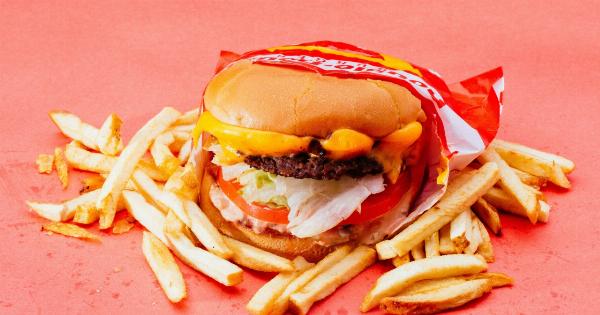Fast food has become an integral part of our modern lifestyle. It’s quick, convenient, and often budget-friendly. However, it’s no secret that fast food is not the healthiest option for our bodies.
With its high levels of saturated fats, sodium, and added sugars, indulging in fast food frequently can have negative implications on our health.
But does that mean we have to completely eliminate fast food from our diets? Not necessarily! By making a few conscious choices and implementing some tricks, we can transform our fast food meals into a healthier option.
Here are some tricks to help you navigate the realm of fast food while still maintaining a nutritious diet:.
1. Opt for Grilled Instead of Fried
Deep-fried foods are notorious for their high fat content due to the oil absorption during the cooking process. Instead of choosing fried chicken or French fries, opt for grilled options.
Grilled chicken sandwiches or grilled fish tacos are not only lower in fat but also retain more nutrients. By making this simple swap, you can significantly reduce your calorie and fat intake.
2. Choose Whole Grain Buns or Wraps
Most fast food joints offer the option of choosing whole grain buns or wraps for your burgers or sandwiches. Whole grains are packed with fiber, essential nutrients, and promote digestive health.
Switching to whole grain bread can help stabilize blood sugar levels, keep you fuller for longer, and provide added nutritional value to your meal.
3. Load Up on Veggies
Fast food meals often lack vegetables, but you can change that! Many fast food restaurants offer the option of adding extra veggies to your burgers, sandwiches, or wraps.
Take advantage of this option and load up on lettuce, tomatoes, onions, cucumbers, and any other available veggies. This will not only add crunch and freshness to your meal but also increase its nutritional value.
4. Ditch the Sugary Beverages
One of the easiest ways to cut down on excess sugar while eating fast food is by avoiding sugary beverages. Soft drinks, milkshakes, and even fruit juices can be loaded with added sugars and empty calories.
Opt for healthier alternatives like water, unsweetened iced tea, or diet soda. If you prefer a flavorful option, try adding a slice of lemon or a splash of lemonade to your water for a refreshing twist.
5. Control Your Portions
Fast food portions have grown significantly over the years, contributing to overeating and weight gain. Be mindful of portion sizes and try not to supersize your meals. Stick to regular-sized options or, if available, choose kid-sized meals.
If you’re still hungry after finishing your meal, resist the temptation to get seconds. Instead, reach for a piece of fruit or some raw nuts as a healthy snack to curb your cravings.
6. Skip the Sauce or Choose Wisely
Sauces and dressings can add extra calories, unhealthy fats, and excessive sodium to your fast food. Opt for mustard, salsa, or vinegar-based dressings instead of creamy dressings like mayo or ranch.
If you can’t resist the sauce, ask for it on the side so that you can control the amount you use. Alternatively, brush or dip your food lightly to minimize the calorie intake without compromising the flavor.
7. Avoid High-Calorie Add-ons
Fast food restaurants often offer various add-ons like extra cheese, bacon, or fried onions. While they may enhance the taste, they can also contribute to an unhealthy meal.
Try to skip these add-ons or, if you can’t resist, ask for smaller portions. For example, instead of going for double cheese, opt for a single slice. It’s all about finding a balance and making small changes to reduce the overall calorie and fat content of your meal.
8. Be Mindful of Condiments
Condiments like ketchup, mayonnaise, and BBQ sauce can be high in sugar and unhealthy fats. Use these condiments sparingly or choose healthier alternatives like mustard, hot sauce, or tzatziki sauce.
By being mindful of the amount of condiments you use, you can cut down on excess calories and create a healthier meal.
9. Plan Ahead and Check Nutrition Information
Planning ahead is crucial when it comes to making fast food healthier. Before you head to your favorite fast food restaurant, take a moment to check their nutrition information online.
Many chains provide detailed nutritional information, allowing you to make informed choices about what to order. Look for meals that are lower in saturated fats, sodium, and added sugars while higher in fiber, protein, and essential vitamins and minerals.
10. Choose Side Salads or Fruit Cups Instead of Fries
French fries are a staple side dish in fast food meals, but they are high in calories, unhealthy fats, and sodium. Consider opting for a side salad, vegetable medley, or a fruit cup instead.
These healthier alternatives will provide you with essential nutrients and fibers while keeping your calorie count in check.
Conclusion
While fast food may seem like an enemy to a healthy lifestyle, with a few tricks and conscious choices, you can make it a part of your diet without sacrificing your well-being.
By opting for grilled options, whole grain buns, adding extra veggies, controlling portions, and being mindful of condiments and add-ons, you can transform your fast food meals into healthier alternatives. Remember, moderation is key, and making small changes can go a long way in maintaining a balanced and nutritious diet.




























